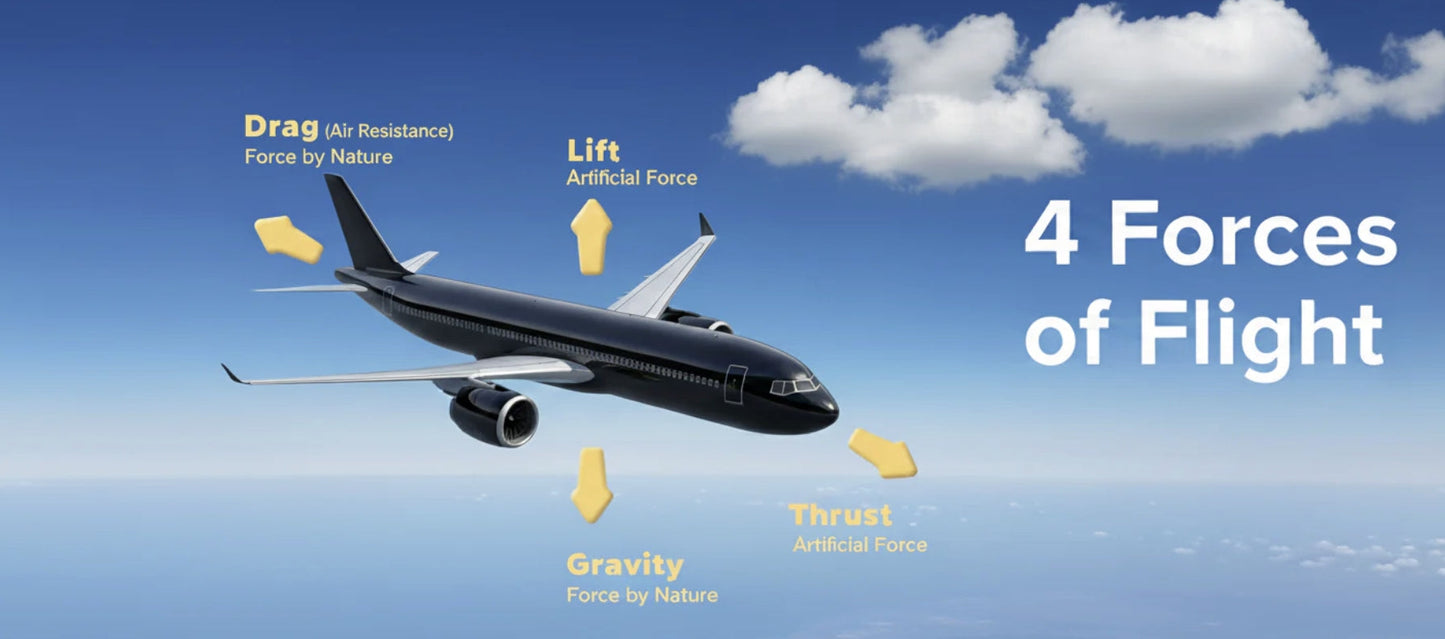
Kore Aviation - If you’ve ever wondered what makes an airplane stay aloft, you’re really asking about the forces of flight. These forces are simple and fundamental. In the aircraft you fly or ride in, forces of flight lift, weight, thrust, and drag are always at work.
By grasping these principles, you’ll better understand why a plane climbs, cruises, stalls, or descends. That knowledge builds confidence in flight training and lets you connect what you see in the cockpit to physics in action.
In this guide, we’ll explore each of those four forces, show how they interact during flight phases, and offer real‑world insight. Let’s take off.
What Are the Forces of Flight?
The term forces of flight refers to four main aerodynamic and gravitational forces that act on every aircraft in motion. These are:
- Lift
- Weight (gravity)
- Thrust
- Drag
These forces act simultaneously. At any moment, some force may dominate, but good piloting means managing their balance.
When the aircraft is in straight, level, unaccelerated flight:
- Lift = Weight
- Thrust = Drag
That equilibrium allows stable altitude and constant speed.
But when you climb, turn, accelerate, or descend, one or more forces change, and the balance shifts.
Lift & Weight — Vertical Forces
1. Lift: How Wings Get You Off the Ground
Lift is the upward force that counters the gravitational pull (weight). It acts perpendicular to the direction of the airflow over the wing.
How Lift Works
- The wing’s shape (airfoil) causes air above to travel faster, reducing pressure above the wing. Lower pressure above vs. higher pressure below produces lift (Bernoulli’s principle).
- Newton’s third law also contributes: the wing pushes air downward, and in reaction the air pushes the wing upward.
- The angle of attack (angle between the wing chord and relative wind) directly affects lift. Too steep and the wing may stall.
Factors Influencing Lift
- Airspeed (faster → more lift)
- Wing area (larger area → more lift)
- Air density (higher density → more lift)
- Angle of attack (within safe limits)
2. Weight: The Pull That Always Works Down
Weight acts downward, toward Earth’s center, due to gravity. It includes the mass of the aircraft, fuel, passengers, cargo, etc.
In flight, weight is constantly evolving, as fuel is burned, the aircraft becomes lighter, shifting its center of gravity slightly.
When lift equals weight, the airplane maintains altitude (if thrust and drag also match). If lift is less than weight, it descends.
Also read: 5 P Checklist Aviation in Single Pilot Crew Resource Management
Thrust & Drag — Horizontal Forces
3. Thrust: The Forward Push
Thrust propels the airplane forward. It is produced by engines (propeller, jet, turbofan). Thrust must overcome drag to accelerate or maintain speed.
When thrust is greater than drag, the aircraft accelerates. When thrust equals drag, speed is steady.
4. Drag: The Resistive Force
Drag opposes forward motion. It is broken into subtypes:
- Parasitic drag: from friction, shape, and surface imperfections
- Induced drag: comes with lift — generating lift causes a byproduct drag
- Wave drag (at higher speeds): from shock waves in transonic/supersonic regimes
As speed increases, parasitic drag rises sharply. As lift increases, induced drag increases too.
Also read: How to Build Flight Time - Strategies for Aspiring Pilots
How the Forces Interact in Flight Phases
Here’s how the forces of flight shift during different stages of flight, and what a pilot must manage:
| Flight Phase | Force Balance | Notes / Pilot Action |
|---|---|---|
| Takeoff / Climb | Thrust > Drag, Lift > Weight | Power full, pitch to climb angle |
| Cruise (level flight) | Thrust = Drag, Lift = Weight | Adjust throttle and trim to maintain balance |
| Descent / Landing | Drag > Thrust (or Thrust reduced), Weight > Lift | Reduce power, manage glide path, use flaps |
| Maneuver / Turn | Some component of lift is diverted horizontally | Adjust bank, increase thrust to maintain altitude |
Discover More: 7 Phases of Flight, Every Stage in the Sky
When you bank, part of lift is used to pull you into the turn, so you may need more thrust or pitch to maintain altitude.
Also, not all thrust is purely horizontal, especially during climbs some thrust vector can have vertical components, slightly assisting lift.
Resultant Force & Vector Concept
Because these four are vectors, the net (resultant) force is their vector sum. If thrust > drag, there is forward acceleration. If lift > weight, there is upward acceleration. Manipulating those allows climb, descend, dive, accelerate, or slow down.
Real‑World Tips for Pilots (Especially Student Pilots)
- Monitor angle of attack: small changes can upset the lift‑weight balance.
- Use clean configuration (flaps, gear) to manage drag.
- Understand how weight changes (fuel burn) shift performance.
- Anticipate transition phases (climb to cruise, cruise to descent) and adjust thrust ahead of time.
- Practice forming mental pictures of force vectors to improve control intuition.
Also, gear matters. When you fly, staying alert to subtle changes in engine or airflow is key.
For student pilots, a crisp, noise‑reducing headset makes a difference.
Explore Kore Aviation premium and affordable headsets, designed for durability to stay sharp in the cockpit.
Why Understanding Forces of Flight Matters
- Safety & control: Knowing how forces change helps you avoid stalls or excessive loads
- Performance planning: Predict climb rates, fuel burn, best cruise speeds
- Design & maintenance: Engineers use these forces to design efficient aircraft and detect aerodynamic issues
- Pilot intuition: You’ll “feel” when one force is winning and know how to respond
FAQs on Forces of Flight
-
Are there more than four forces of flight?
In heavier‑than‑air flight, no. The primary forces are lift, weight, thrust, and drag. In lighter‑than‑air flight (balloons), buoyancy matters. -
Why does induced drag increase when lift increases?
Because generating lift disturbs airflow and creates vortices and higher pressure differences, which cost energy, hence induced drag. -
Can thrust help with lift?
In some aircraft, thrust vectoring or propeller slipstream helps airflow over wings, giving a small lift component. -
What happens if drag becomes greater than thrust?
The airplane will decelerate; if drag overcomes thrust and lift is less than weight, descent begins. -
How does altitude affect the forces of flight?
At higher altitude, air density is lower, which reduces lift and thrust effectiveness. You may need higher airspeed or more angle of attack to compensate. -
Does load (weight) distribution matter along with total weight?
Yes. If CG is too far forward or aft, handling suffers and the ability to control pitch is compromised. -
Why four forces and not more?
Because all external forces on an airplane in air reduce to those four fundamental categories: lift, weight, thrust, and drag. Other forces are derivatives or combinations of them. -
Can lift act forward or backward?
Normally lift acts perpendicular to the relative wind. In extreme maneuvers, components may shift, but as a principle, lift is not a forward/backward force. -
Is the forces of flight the same for gliders?
Yes. Gliders have no thrust, so they descend while converting potential energy. But lift, weight, and drag still apply. -
Does altitude change forces?
Yes. At higher altitude, air density drops, reducing lift and thrust effectiveness; drag lowers too, but pilots must adjust. -
How do winglets reduce drag?
Winglets reduce induced drag (a byproduct of lift) by weakening wingtip vortice
Conclusion
In aviation, mastering the forces of flight, lift, weight, thrust, and drag is essential. These four forces are always at work, interacting and shifting as you climb, cruise, turn, or descend. When you internalize how they relate, every flight feels more intuitive.
If you’re a student pilot or aviation enthusiast, gear matters too. A good headset is a companion in the cockpit and during training. Check out Kore Aviation’s headset options, designed for pilots to stay sharp from ground school to solo cross‑countries.
Fly safe, stay curious, and enjoy discovering how the forces of flight really shape your time in the sky!

